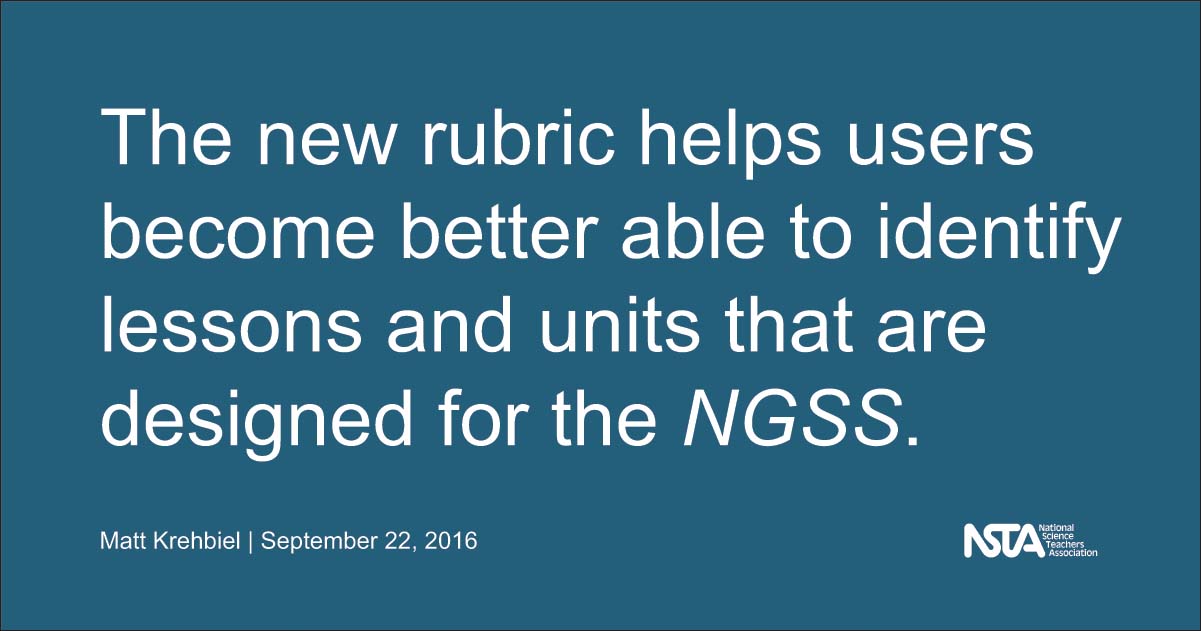 The Educators Evaluating the Quality of Instructional Products (EQuIP) Rubric for science provides criteria by which to measure the degree to which lessons and units are designed for the Next Generation Science Standards (NGSS). The rubric is a joint project of Achieve, Inc., and NSTA and was originally released shortly after the NGSS were finalized.
The Educators Evaluating the Quality of Instructional Products (EQuIP) Rubric for science provides criteria by which to measure the degree to which lessons and units are designed for the Next Generation Science Standards (NGSS). The rubric is a joint project of Achieve, Inc., and NSTA and was originally released shortly after the NGSS were finalized.
The purpose of the rubric and review process is to: (1) review existing lessons and units to determine what revisions are needed; (2) provide constructive criterion-based feedback and suggestions for improvement to developers; (3) identify exemplars/models for teachers’ use within and across states; and (4) to inform the development of new lessons, units, and other instructional materials.
Revisions were recently made to the rubric. Matt Krehbiel, assistant director of science for Achieve, Inc., highlights some of the changes in the following Q&A.
Q: What are the major changes that were made to the rubric?
A: The two biggest changes in the rubric are the addition of a scoring guide to the response form and the reorganization of criteria in the first two categories of the rubric. The details of these and other changes are outlined in Rubric Changes for Version 3.0 online.
Q: Why were the changes made?
A: The scoring guide was added to support the evaluation of lessons and units in a more concrete way. This version of the rubric will be used to vet lessons and units by the Peer Review Panel with the goal of identifying and sharing high quality lessons designed for the NGSS. The scoring guide supports the process of selecting high quality examples.
The criteria were reorganized to provide greater clarity about what designing lessons and units for the NGSS really looks like. While training thousands of educators to use the EQuIP Rubric for Science, we have observed where people struggle to understand the intent of the criteria and revised these sections for greater clarity.
Q: How were the changes made?
A: It was a team effort. Feedback from the thousands of educators using the EQuIP Rubric for Science across the United States was combined with feedback from those leading professional learning using the rubric and the revisions were guided by the same group of experts that authored previous versions of the EQuIP Rubric for Science. It was a year-long, iterative process that included piloting several drafts with groups of teachers for specific feedback on the clarity and utility of the changes.
Q: What does the new rubric allow me to do?
A: The new rubric allows for a more specific conversation about what is “quality” in terms of designing lessons and units for the NGSS. Together with professional learning support, the new rubric helps users become better able to identify lessons and units that are designed for the NGSS, better able to revise lessons and units of their own, and helps deepen their understanding of the standards themselves and what they expect of students and teachers. It is important to note that the rubric is best used within a community and, when used this way, it can also establish or reinforce a common language and understanding for what high quality lessons and units designed for the NGSS look like.
 Matt Krehbiel is Assistant Director of Science for Achieve, Inc. Reach him at mkrehbiel@achieve.org and follow him on twitter at @ksscienceguy.
Matt Krehbiel is Assistant Director of Science for Achieve, Inc. Reach him at mkrehbiel@achieve.org and follow him on twitter at @ksscienceguy.
Visit NSTA’s NGSS@NSTA Hub for hundreds of vetted classroom resources, professional learning opportunities, publications,ebooks and more; connect with your teacher colleagues on the NGSS listservs (members can sign up here); and join us for discussions around NGSS at an upcoming conference.
The mission of NSTA is to promote excellence and innovation in science teaching and learning for all.
Future NSTA Conferences
2016 Area Conferences
2016 National Conference
Follow NSTA



